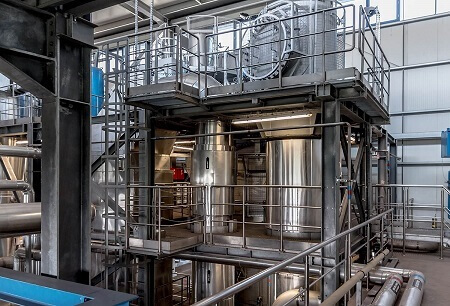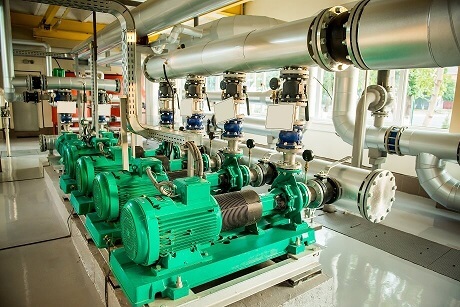Power Generation Industry
The power generation industry utilises a wide range of pumps to fulfil many different applications. Two of the most commonly used pumps within power plants are high-pressure multi-stage pumps to deliver high-pressure water for boiler feed applications and centrifugal pumps which are utilised for powerplant cooling.
Boiler Feed
Power plants utilise steam to drive turbines which in turn generate power. Steam is delivered to the boilers through the use of multi-stage pumps delivering relatively low amounts of water at pressures exceeding 50 Bar. Such pumps will be variable speed to accommodate fluctuations in demand. Boiler feed pumps often have limited amounts of NPSH available and consequently are used in conjunction with booster pumps to eliminate NPSH issues with booster pumps feeding the main boiler feed pump. Sealing on such pumps can be done by either mechanical seal or by packed gland which can be preferred during low NPSH conditions as mechanical seals can experience accelerated wear during such conditions.
Cooling pumps
Cooling pumps are used to cool steam after it has passed through turbines to enable the water to be reused. Steam usually travels to a cooling tower where water is pumped to cool steam via a high flow centrifugal pump known as a double suction pump. Double suction pumps deliver high flows at low heads into cooling towers where steam is cooled which returns back to a condenser where water is reused for steam.
Dosing
As water is continually reused from cooling towers within a closed-loop system the water can become contaminated due to it coming into contact with particles, and atmospheric dust. Also due to the nature of the process with the water being repeatedly boiled the level of dissolved solids within the water continually increases which leads to scale accumulation and calcification forming within the system. Furthermore, the process conditions - warm, mist and stagnant water create an ideal environment for the growth of legionella bacteria. Dosing systems are therefore required for microbial control with biocides being dosed to prevent legionella and also prevent scaling.
Condensate return pumps
To return condensate water back for reuse typically side-channel pumps are used which have a low NPSH as water can be vapour. Side-channel pumps produce low flows and high heads to reintroduce condensate back into the system.
Reactor cooling
Nuclear reactors utilise liquid CO² for cooling. Due to the temperature of CO² which can be <-50°C and the required inlet and discharge pressures which can be in excess of 40 bar, pumps with low flows and high heads are utilised specifically designed for CO² – Magnetic Drive Side Channel pumps. The magnetic drive design eliminates the possibility of seal failure but also ensure the high pressures are contained within the pump head.
Lubrication
Pumps are also used for the lubrication of equipment such as conveyors, gearboxes, bearings and other rotating machinery. Lubrication pumps can be shaft driven by a rotating assembly such as within a wind turbine via a shaft output from gearbox or air-driven for extracting grease from barrels. Electric driven pumps are used if part of a central lubricating plant.
Combined Heat and Power Plants
Combined heat and power plants utilise a mixture of fuels to generate heat and power. Such plants may be designed to utilise gas as the main fuel but as a backup use Light Distillate Oil (LDO) and Crude Oil (CO) as a way to drive turbines during high demand or low gas supply. Such fuels will be transferred using screw or gear pumps at high pressures due to the distance between fuel tanks and burners but also to create fine mists which are ignited through nozzles. Such plants can often be located within areas away from large sources of water and so the use of air-cooled equipment is preferred.
The pump features which are often utilised within the power generation industry include:
Variable Speed Drive – to accommodate multiple duty points and variations in demand.
Magnetic Drive – to eliminate the need for process seals which may leak
Relief Valves – to prevent damage to pumps but also excess system pressures
Wide viscosity range handling particularly if Crude Oil is handled which can vary significantly with temperature.
Long service intervals ensuring pumps experience little downtime and maintenance can be scheduled for during plant shutdown.




